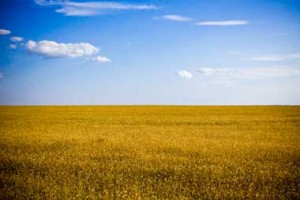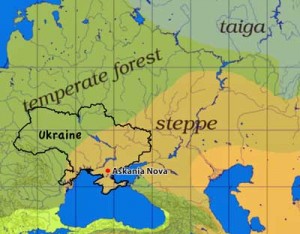
Sea of grain: agricultural landscape on former steppe land resembling the colors of the Ukranian flag. Source: Wikipedia.
The steppes of Ukraine and Russia were once a sea of grass on rolling plains on which pastoral nomadic peoples grazed their herds of livestock. From the eighteenth century, the steppes have been transformed into a major agricultural region. This process started after the region was annexed to the Russian Empire and settled by migrants from forested landscapes in central and northern Russia and Ukraine and also from central Europe. By the twentieth century, the former steppe landscape had almost disappeared, save a few remnants protected in nature reserves (zapovedniki).

Map of the steppe region showing Ukraine and location of Askania Nova Biosphere Reserve. Modified from Pontic/Caspian vegetation zones map. Source: Wikipedia.
In this podcast episode, David Moon, Anniversary Professor in History at the University of York, UK, talks about his recent visit to the Ukrainian steppes. In addition to conventional historical research in archives and libraries in Odessa, he travelled through the steppes, visited nature reserves, and met scientists to help him understand how the landscape had been transformed over time. This episode provides fascinating insights into the environmental history of the steppes and the way that environmental historians go about studying the history of landscapes and environments.
Relevant web links
Guest blog on OUP website by David Moon
Book by David Moon: The Plough that Broke the Steppes Agriculture and Environment on Russia’s Grasslands, 1700-1914 (Oxford: OUP, 2013)
Wikipedia page Askania Nova.
Music credits
“Echo of the Steppe” by Julian Kytasty on the Bandura, Link Media, Inc. From: Internet Archive,http://www.archive.org/details/linktv_world-music-blog-videos20090504.
“Where You Are Now” by Zapac
Available from ccMixter
“Sooner or Later” by Geert Veneklaas
Available from ccMixter


Recent Comments